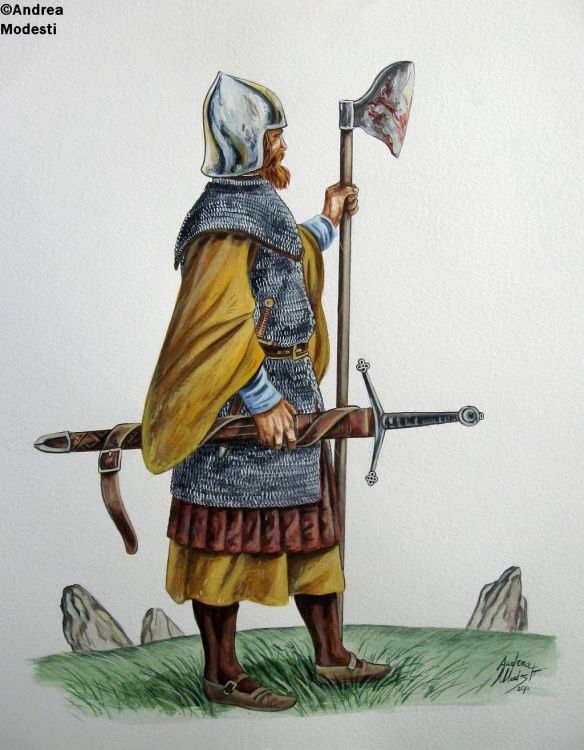“galloglasses” (gallóglaigh, troops of heavy-armored Scots from the Western Isles). The first galloglasses arrived in the mid-thirteenth century, but their numbers were reinforced by political exiles from Scotland after the Bruce wars. They too were billeted on peasant farmers in the Gaelic lordships, an exaction known as “coyne and livery.”
Conor O’Dea of Thomond and a small contingent of Munstermen held the ford of the Fergus river against an advancing Anglo-Irish force under Richard de Clare. De Clare heedlessly rushed across the river with some of his knights, only to be surrounded and killed. De Clare’s main force then crossed over and surrounded the O’Deas in turn, but were thrown into disarray by the arrival of Irish reinforcements and routed.
The armies of the Irish chieftains over the same period became increasingly professional. Instead of relying on musters of their own subjects, chiefs employed bands of “kernes” (ceithirne, ceatharnaigh; light-armed native Irish mercenaries) and “galloglasses” (gallóglaigh, troops of heavy-armored Scots from the Western Isles). The first galloglasses arrived in the mid-thirteenth century, but their numbers were reinforced by political exiles from Scotland after the Bruce wars. They too were billeted on peasant farmers in the Gaelic lordships, an exaction known as “coyne and livery.” The chieftains themselves, with their families and household guards, formed the cavalry, wearing suits of mail and helmets, and armed with long spears. A series of major Irish victories in the fourteenth century demonstrated their effectiveness: in 1318, at Dysert O’Dea, where the death of Lord Richard de Clare and the subsequent failure of his heirs ensured lasting independence for the Ua Briain lordship of Thomond; in 1346, when Brian Mór Mac Mathgamna (MacMahon) of Monaghan defeated the Anglo-Irish of Louth, killing four hundred of them; or in 1374, when Niall Mór Ua Néill defeated and killed the Seneschal of Ulster at Downpatrick. However, real territorial gains for the Irish chiefs came from a gradual war of attrition on the borders of the colony, resulting in considerable expansion for Ua Conchobair Failge (O’Conor Faly) along the southern borders of Meath and Kildare, for Ua Broin and Ua Tuathail (O’Byrne and O’Toole) in Wicklow, for Mac Murchada Caemánach (MacMurrough Kavanagh) in Wexford and Carlow, and for Ua Cerbaill (O’Carroll) in Tipperary. In Ulster, the murder of Earl William de Burgh in 1333, and the absenteeism of his heirs, led to virtual independence for the chiefs there, but in Connacht and Desmond, or south Munster, the Anglo-Irish Burkes and Fitzgeralds respectively dominated the local chiefs, although the English government itself had little control in those areas.
